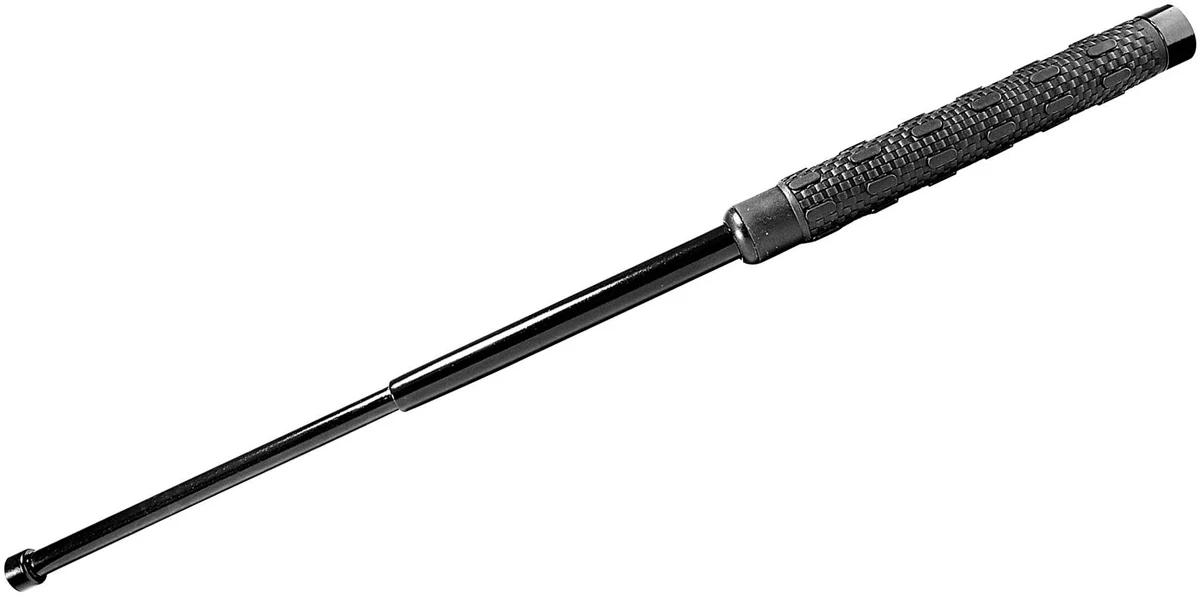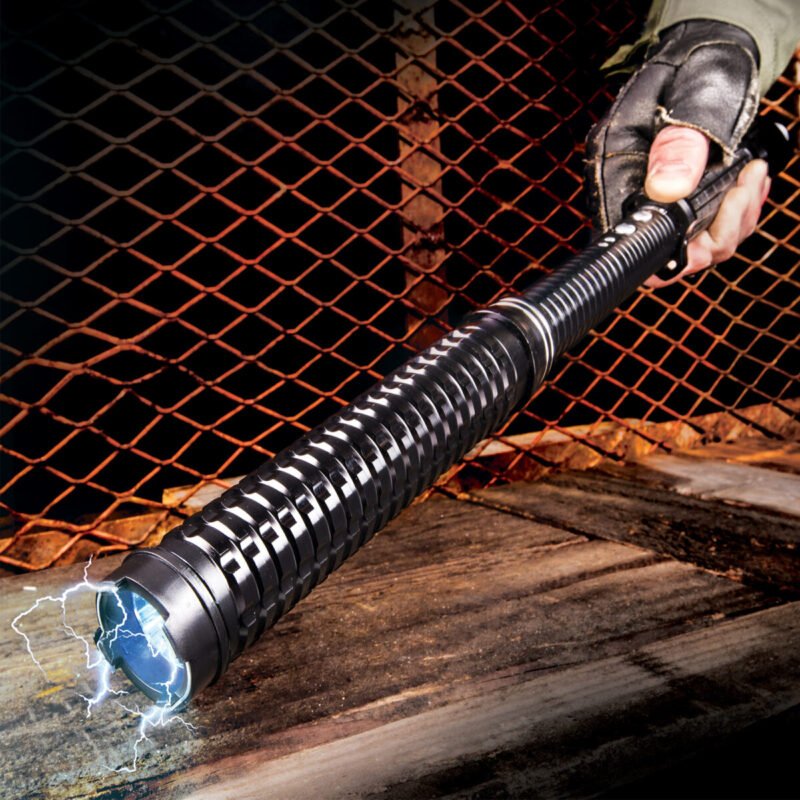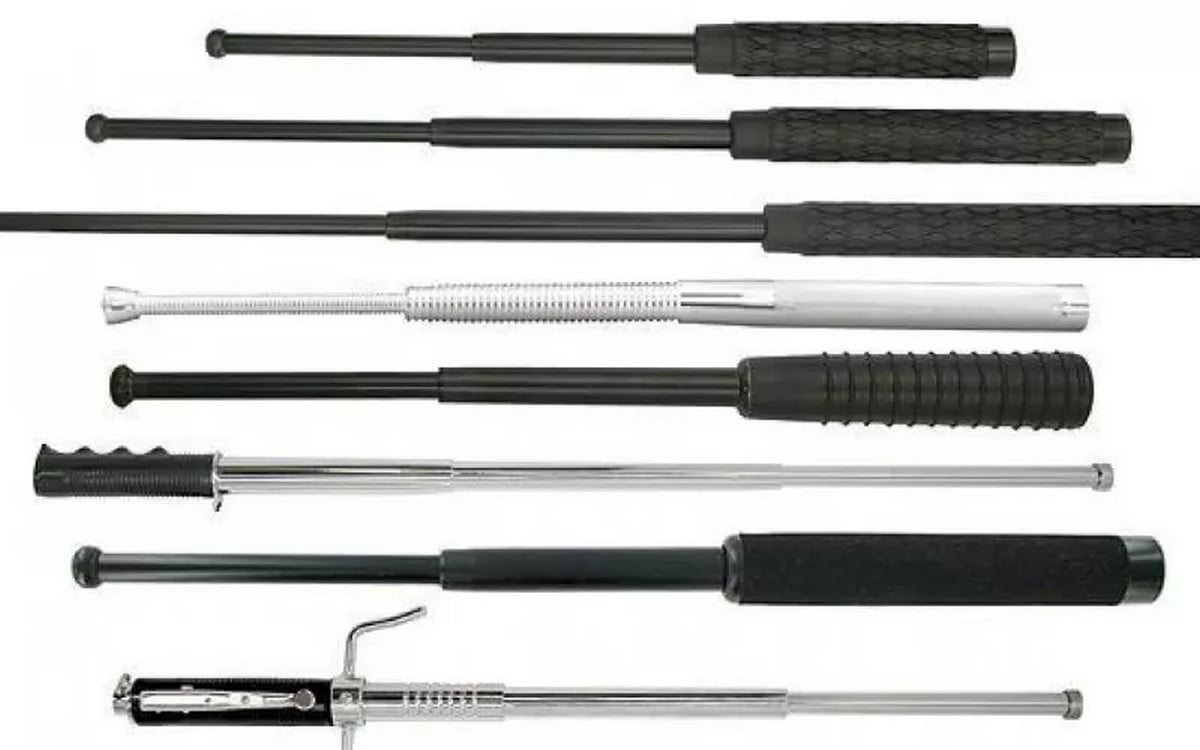What is a Baton?
Safety batons more commonly known as police batons and police nightsticks are a self-defense tool as ancient as man. The British also refer to them as truncheons. No matter what these short heavy sticks are called, most safety batons are made of rubber, wood, metal, or polycarbonate (plastics). They are considered a category of non-lethal self-defense. These self-defense sticks/ police sticks require specialized training and cause serious injuries depending on the strike area and the force applied. These come in varying sizes styles and designs depending on the type of use.
History and Evolution of Modern Safety Batons
Historically known as a billy club or nightstick, the law enforcement batons have been a symbol of authority and a tool for law enforcement for centuries. Its origins can be traced to the ceremonial maces of the early 19th century at Yale University, evolving from a symbol of leadership to a practical weapon. During the 19th and 20th centuries, standard wooden batons were issued to police officers, becoming synonymous with law enforcement in both the UK and the US.

Over the years, technological advancements and public scrutiny led to significant changes in baton design and use. In the 1970s, the side handle baton was introduced amidst civil rights era police reform efforts, intended to offer both offensive and defensive capabilities while mitigating public concerns about police brutality. The 1980s saw the rise of collapsible batons, enhancing portability and convenience for officers on duty.
Modern developments have introduced multifunctional batons that combine traditional features with tools like tactical flashlights and glass breakers. Despite the shift towards less lethal alternatives like tasers and pepper sprays, cop batons remain an essential part of police gear, reflecting an ongoing evolution aimed at balancing effectiveness with ethical considerations in law enforcement.
Best Expandable Baton for Self-Defense
Expandable batons have become essential self-defense tools in light of increasing crime rates, favored by both civilians and military personnel. These less-than-lethal weapons strike a balance between reach, power, and portability, making them versatile and effective for personal protection. The 21-inch baton is mostly regarded as the best choice for most users, offering an optimal mix of striking range and force while remaining compact enough for everyday carry in a holster, belt, or backpack. This size is preferred for its ability to provide powerful defensive strikes and maintain a safe distance from an attacker.
For those prioritizing portability and discreet concealment, go for a 16 inch baton which is a compact and lightweight option. On the other hand, the 26 inch baton would be perfect for extended reach beneficial for law enforcement and security personnel in crowd control situations and when dealing with larger threats. The choice of baton length should be based on individual needs, typical usage scenarios, and physical capabilities.
Editor’s Choice
- Monadnock Persuader (Retracted Length: 6”, Weight: 0.10 lbs.)
- Safety Tech Expandable Steel Keychain Baton (Retracted Length: 5.5”, Expanded Length: 12”, Weight: 9 oz.)
- ASP Agent Concealable Baton (A40) (Retracted Length: 7.75”, Expanded Length: 16”, Weight: 13.2 oz.)
- ASP Talon Disc Loc Baton (Retracted Length: 7.06”, Expanded Length: 16”, Weight: 16.3 oz.)
- Streetwise™ Expandable 19″ LED Stun Gun Baton 30M (Retracted Length: 16.5”, Expanded Length: 19”, Weight: 2.05 lbs.)
- Smith & Wesson Heat Treated Collapsible Baton (21″) (Retracted Length: 8.5”, Expanded Length: 21”, Weight: 13.2 oz.)
- Rothco Solid Steel Expandable Baton w/ Nylon Holster 21″ (Retracted Length: 8.31”, Expanded Length: 21”, Weight: 1.15 lbs.)
- Smith & Wesson Heat Treated Collapsible Baton (24″) (Retracted Length: 9”, Expanded Length: 24”, Weight: 14.8 oz.)
- PR-24 Expandable Side-Handle (21”) (Retracted Length: 14”, Expanded Length: 24”, Weight: 2.2046 lbs.)
- Police Force Tactical Expandable Solid Steel Baton 26” (Retracted Length: 10”, Expanded Length: 26”, Weight: 1.4 lbs.)
How Safety Batons Are Used for self Defense
Sfateu batons are used to stop an attack combat an assailant or create a distance between you and the aggressor. Safety batons, particularly telescopic batons, are highly regarded in self-defense for their effectiveness and versatility. In a self-defense scenario, the presence of a baton can be a deterrent, as the prospect of being struck by it is generally unappealing to potential attackers.
If the aggressor persists, the baton can be used to deliver strikes to sensitive areas, causing significant pain and temporarily incapacitating the attacker and giving you a chance to escape. It isn’t about being able to wield the weapon rather it needs specific training for different scenarios.
The baton training usually covers various striking techniques, how to maintain an optimal distance from an assailant, and methods to control or neutralize a threat effectively. Moreover, understanding the legal implications of carrying batons and using them for self-defense is essential, as regulations can vary significantly by location
Tips & Tricks for Baton Use
Deployment and Use
Deployment
Avoid deploying the baton mid-fight. It should be ready before the confrontation escalates.
A quick and decisive flick of the wrist is necessary for proper deployment.
Striking Techniques
Target Limbs: Focus on hitting arms and legs to incapacitate rather than going for headshots, which can be lethal.
Pain Compliance: Use strikes to inflict pain and gain compliance rather than aiming to cause serious injury. Aim for areas like thighs and biceps.
Proper Striking: Keep the elbow bent and swing the baton close to your body to increase the tip speed and power.
Defensive Use
Use the baton to block or parry incoming strikes and maintain distance to keep yourself safe from grabs and strikes.
Situational Considerations
LEO (Law Enforcement Officers)
Wrist locks and grappling techniques can be useful when dealing with semi-compliant opponents.
The baton is a non-lethal tool but should be used with caution and within legal boundaries.
Training and Mindset
You can also consider training in Filipino Martial Arts (FMA) like Kali or Escrima to learn stick fighting fundamentals, which can be easily adapted for baton use. Practice deployment, striking, and defensive techniques regularly. Before deciding, always consider the ethical and legal implications of using any weapon for self-defense.
We talk about the techniques of using a baton in more detail on our blog here. We extensively discuss some of the techniques mentioned in the handbook of the Department of Justice and important techniques from our experience.
Different Types of Safety Batons
1. Collapsible Baton
A collapsible baton, also known as a telescopic or extendable baton, consists of multiple sections that slide out to form a longer baton and retract back into a compact form for easy storage. This portability makes it an excellent choice for personal safety, especially for individuals who are always on the move. Typically made from durable materials like steel or aluminum, collapsible batons can be carried discreetly in a holster or pocket. When deployed, they extend with a swift flick of the wrist, providing an immediate tool for self-defense.

The collapsible baton is particularly effective for close-range encounters. Its design allows for rapid expansion, giving the user the element of surprise and an intimidation factor when confronting a threat. The tip of the baton, being solid and impactful, can be used to target sensitive areas such as the knees, elbows, or wrists to effectively neutralize an aggressor without causing excessive harm.
2. Fixed Batons
Fixed batons are traditional batons that do not extend or retract. Commonly used by law enforcement, these batons are ready to use without any need to unfold or adjust, offering immediate response capabilities. They are typically longer and thicker than collapsible models, which makes them somewhat less portable but more formidable in terms of the force they can deliver.

Due to their robust construction, fixed batons are effective in incapacitating an assailant quickly and efficiently. They are ideal for security personnel or individuals in environments where threats are more probable and a strong defensive response is necessary. Fixed batons can be used to block attacks and deliver powerful strikes that can incapacitate an attacker, making them essential in close-quarter combat scenarios.
3. Stun Batons
Stun batons incorporate electronic components that can deliver a high-voltage, low-amperage shock. This technology is designed to incapacitate an aggressor temporarily without causing lasting harm, making stun batons an excellent choice for self-defense for those who wish to avoid physical confrontations. The electrical shock affects the muscle function of the aggressor, momentarily disabling them and providing the user a chance to escape or seek help.

The design of a stun baton typically includes safety features to prevent accidental discharge and ensure that the device can only be used when intentionally activated. This aspect is particularly valuable in avoiding misuse or unintended injuries. Stun batons are effective not only because of their physical deterrent but also due to their psychological impact, as the visible arc and crackling sound can be very intimidating.
Is It Legal To Carry a Baton in My Car?
The legality of carrying an expandable baton in your vehicle varies significantly based on local laws and regulations. Generally, expandable batons are categorized as concealed weapons due to their ability to be compacted and easily hidden. Because of this classification, many states have specific statutes or regulations that either restrict or outright prohibit the possession of such devices in a concealed manner.
To understand whether it is legal to carry an expandable baton in your car, you must consult the specific laws of your state or locality. These laws often use broad terms to define what constitutes a concealed weapon and what is permissible. For instance, some states may allow the carrying of expandable batons in vehicles as long as they are visible or secured in a specific manner, while others might require a permit or prohibit them entirely.
For an in-depth exploration of the legalities surrounding expandable batons, you can refer to resources such as state government websites, legal databases, or our comprehensive blog post. These sources provide detailed analyses of weapon laws and can offer guidance on how to comply with them in your area. It’s also advisable to consult with a legal professional or law enforcement in your jurisdiction to get accurate and up-to-date information.
Alternaitves to Safety Batons
Tasers & Stunguns
Tasers represent a significant advancement in non-lethal self-defense technology, providing a safer and more controlled alternative to traditional safety batons. A taser works by delivering a high-voltage, low-amperage electrical charge through two small dart-like electrodes which temporarily disrupts the body’s neuromuscular system without causing permanent damage. The effective range of a taser can vary between 15 to 30 feet.
Tactical Flashlights for Self-Defense
Self-defense flashlights are tactical tools designed to provide safety in multiple ways. Firstly, they emit a high-intensity beam that can temporarily blind an assailant, giving you some time to react. These tactical flashlights are constructed with durable materials like aircraft-grade aluminum, often with a crenulated bezel that can be used effectively as a striking tool in close encounters. Their sturdy build ensures longevity and adds to their utility in self-defense situations.
Pepper Spray
Pepper spray is a popular self-defense tool because it is effective, easy to use, and non-lethal. It can incapacitate an attacker by causing temporary blindness and intense pain without causing permanent damage. Its small size makes it easy to carry discreetly, and it provides a sense of security for individuals in potentially dangerous situations. Furthermore, pepper spray is generally legal and available, making it an accessible option for personal safety.
Tactical Pen
A tactical pen is a versatile tool designed to serve as a writing instrument and a self-defense weapon therefore can be easily concealed these are also made with heavy-duty materials. The discreet appearance of a pen allows it to be carried almost anywhere, making it a reliable option for those looking to enhance their safety on the go. The pointed tip and solid construction enable the user to target pressure points or use it as a striking tool during an emergency. Tactical pens often include additional features such as glass breakers, further augmenting their utility in crises.
Conclusion
Used historically and in modern times by law enforcement and civilians alike, safety batons serve as non-lethal weapons designed to incapacitate assailants and provide a means of defense. Over the years, the design and usage of batons have evolved, reflecting advancements in technology and changing societal expectations about law enforcement practices.
Now we have many options available regarding safety batons, fixed, expandable, or stun batons. While batons remain a staple in self-defense, alternative tools like tasers, pepper spray, and tactical flashlights offer additional non-lethal options for personal protection. Legal considerations are paramount when carrying batons, as regulations vary by location and improper use can lead to legal consequences. Ultimately, safety batons and their alternatives provide a good option for individuals to protect themselves while adhering to ethical and legal standards.
FAQs
1. Are expandable batons good for self-defense?
Yes, they are compact, easy to carry, and can be quickly deployed when needed, which makes them effective self-defense weapons. Their design allows them to extend from a shorter, more manageable size to a longer length, which can provide a significant advantage by increasing reach and delivering powerful strikes.
2. What is the best length baton for self-defense?
The best length for a self-defense baton typically is 21” inches when fully extended. Most batons of this size are comfortable to carry and handle.
3. What is the use of a security baton?
Security batons or police batons are primarily used by law enforcement, security guards, and military personnel for situations such as self-defense, crowd control, and compliance enforcement. These serve as non-lethal weapons before resorting to extreme measures.

